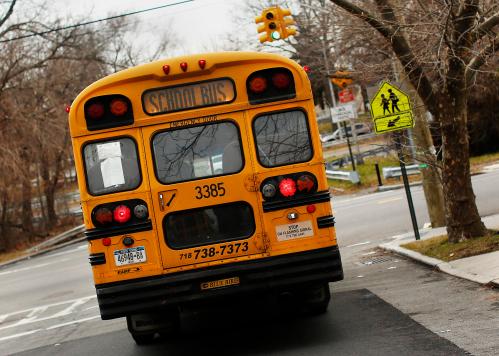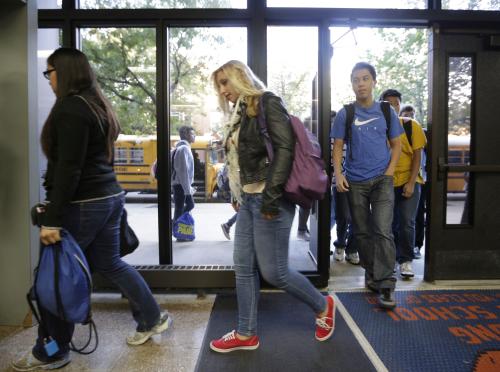Integrating U.S. schools by race and class has never come easily, as evidenced by the slow implementation of Brown v. Board of Education in the 1950s, the fierce resistance to school busing programs in the 1970s, and the often-futile efforts to redraw school boundaries. Questions about which children attend which schools profoundly affect the interests of parents and homeowners. Consequently, the politics and policy of school integration are inseparable, and the list of successful integration efforts is short.
School choice reforms, including charter schools and open enrollment programs, present an enticing possible solution to the problem. If parents request schools more diverse than their residential neighborhoods, then Americans might choose their way to less segregated schools. Secretary of Education Betsy DeVos has expressed confidence in this view in both written and spoken remarks. Unfortunately, a growing body of research on the relationship between school choice and segregation suggests that the mere presence of charter schools or other choice programs does not markedly integrate schools. School choice programs might (or might not) help—and school-choosing parents might even seek out diverse schools—but the potential is limited without an accompanying policy effort to promote integration.
This post examines the politics of school integration, the tools available to policymakers to integrate choice-based systems, and the relationships between the two. Those tools, I argue, are plentiful and varied, although the viability of any particular tool depends on local politics and policy.
The politics of integrating schools of choice
Earlier this month, the New York City Department of Education released its plan to address segregation within a system that has embraced an assortment of choice reforms. Public expectations dissipated from May 2016, when Mayor Bill de Blasio pledged a “bigger vision” for school integration, to May 2017, when he conceded that he couldn’t “wipe away 400 years of American history.” When the department released its plan, it did so without much fanfare, perhaps anticipating the disappointed reception from critics who found the reforms timid and lamented that the plan avoided the words “integration” and “segregation.”
In fact, the department’s “Equity and Excellence for All” report outlines several approaches to improving integration, from changing admissions preferences to setting specific diversity goals. Conspicuously absent, however, were the most surefire—and controversial—approaches to school integration, such as a controlled choice plan that would use socio-economic status as a factor to engineer diversity within schools. The plan and its rollout, in other words, were not shining examples of political courage, although they provide an interesting glimpse into the politics of integrating schools of choice, where good intentions often meet parents’ and homeowners’ interests. The plan also seems consistent with broader realities of U.S. politics. For example, allocating scarce, desirable resources based on race or socio-economic status is generally unpopular, while making resources universally available—even if those resources disproportionately benefit disadvantaged groups—tends to be more palatable.
Tools for integrating choice-based school systems
There are two basic approaches, not mutually exclusive, to integrating schools in choice-based systems: First, change which schools families request, and second, change how students are placed based on those requests.
Approach 1: Change which schools families request
The rhetoric of school choice reform evokes the sense that a laissez-faire government should step aside and let parents and schools do as they please. However, policymakers and education organizations have critical roles to play in shaping parents’ school requests. Choosing schools is difficult, even in the best-designed systems, and thoughtful interventions can bring families’ requests into better alignment with their desires.
Most fundamentally, governments can manage the supply of seats available by strategically opening, expanding, and closing schools. Richard Kahlenberg, for example, has advocated for locating charter schools in mixed-income areas and on borders between affluent and poor communities, along with recruiting school operators committed to recruiting, admitting, and integrating diverse groups of students.
Even without changing the supply of seats, policymakers can affect families’ school requests. Improving the support available to school-choosing families can benefit families lacking access to high-quality information and support, a particularly acute issue for low-income families. For example, local policymakers can adopt a common application that eases the burden of navigating school-specific deadlines and requirements (and limits opportunities for desirable schools to keep certain students out). They can improve the quality and dissemination of information, which helps families understand how to get a desired placement—and might nudge families to higher-performing schools. They can improve transportation services, providing access to schools beyond one’s own, often racially and economically homogenous, neighborhood.
Approach 2: Change how students are placed based on families’ requests
Of course, policymakers also have control over what happens after families select schools. Perhaps the most ambitious approach to integrate schools at this stage is a controlled choice plan like the one used by Cambridge, Mass. Families submit their school requests and then administrators place students based families’ requests, student assignment preferences (e.g., having a sibling enrolled), and a set of diversity factors—like socio-economic and special education status—that the district uses to create diverse school populations. Controlled choice is the scalpel within the toolkit for integrating schools of choice, precise in the demographics it can create. It is also among the most controversial tools for its explicit consideration of student background in allocating seats.
In recent years, several large cities—including New Orleans, Denver, and Washington, D.C.—have adopted a unified enrollment system that, along with centralizing school applications, uses a centralized algorithm to place students in schools. These systems assign seats based on families’ (ranked) school requests, school capacity, and school priority categories. In principle, these school priority categories could include the demographic characteristics from controlled choice plans among their criteria, and some schools do; Bricolage Academy in New Orleans, for example, gives priority to economically disadvantaged applicants for up to 33 percent of available seats. In practice, though, most cities have opted for categories that prioritize siblings of current students, children of school employees, and families that live in school’s broad geographic area.
However, what happens behind the veil of these algorithms can have important implications for school integration. Decisions about which priority categories to use—and how to rank and implement them—can affect the allocation of high-demand seats in oversubscribed schools. Some priority categories are generally diversity enhancing. This includes, for example, preferences the New Orleans OneApp has given at times to students who previously attended a low-rated or closing school. Other priority categories (or requirements) are generally diversity stifling. This includes New York City’s controversial practice of giving priority to students who visit a school’s information session, open house, or High School Fair table. The “Equity and Excellence for All” plan pledges to end that practice, citing the particular burden on parents working long hours or multiple jobs. Finally, some priority categories—like geographic preference zones—can be either diversity enhancing or diversity stifling depending on their implementation.
Good news, bad news
While just providing families with school choice options seems unlikely to integrate schools, policymakers have a rich set of tools available to promote that effort. Some of these tools directly shape the composition of schools, like giving priority to students based on their family backgrounds, while others operate more subtly. Some tools are plainly visible to the public, while others, like nuances in placement algorithms, are harder for people to see and understand. On one hand, the complexity of these tools raises concerns about transparency. On the other hand, transparency and political processes have not always helped with integrating schools, so complexity could yield opportunity. Regardless, the tools that are right for one city—in the context of that city’s politics, policies, and goals—might not be right for another.
The Brookings Institution is committed to quality, independence, and impact.
We are supported by a diverse array of funders. In line with our values and policies, each Brookings publication represents the sole views of its author(s).








